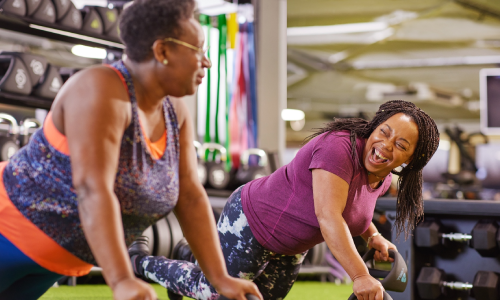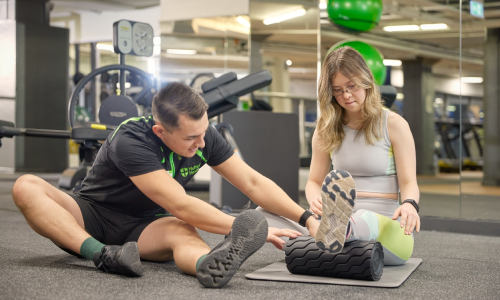Resistance training workout for beginners
- Overview
Before you start working various different areas of the body, we’ll walk you through the warm-up, the best compound lifts for you, and cooling down afterwards.
What’s involved?
Warm up
Warming up should raise your heart rate and prepare your body for the rest of your workout.
Replicating some movements that you might be using in the workout can be helpful too. If you can’t perform certain movements during the warm up, don’t worry. Getting warm is all about getting your heart rate up, so find and use movements and exercises that work for you and your body.
Workout
This resistance workout incorporates a number of compound exercises.
Compound means that the movement uses multiple muscles or groups of muscles. This is ideal if you can’t fit in multiple sessions where you split your workout days into different muscle groups.
Cooling down
Cooling down is important for everyone, but it's even more necessary if you take medication or suffer with a cardiac condition. Find a gentle activity that keeps your body moving whilst bringing your heartrate back down to a resting level.
Remember to find a routine that works for you and your body.
How much effort should I put in?

With all these exercises, you want to be putting effort into each movement. How much effort all depends on your goals.
If you’re looking for muscular endurance, we recommend performing 12 to 15 repetitions of each exercise.
This means you're working each muscle hard and making sure the last repetition is around the most you can manage. If you find you can do a lot more, you might want to consider using a slightly heavier weight.
How many sets should I do?
How many sets we recommend you do all depends on your goal. See below for guidance: How many sets we recommend you do all depends on your goal. See below for guidance:
- If you’re lifting weights for the first time or returning to resistance training after some time off, we recommend starting with more reps of a lower weight. This allows your body to adjust to the movements again before moving onto heavier weights and fewer repetitions.
- If muscle growth is your primary goal, you might want to do 3 sets of 8 to 10 repetitions instead. If you’re lifting heavier weights, it’s recommended you take a slightly longer break of around 60 to 90 seconds between sets. This gives your muscles time to recuperate and prepare for the next set.
- If your focus is improving strength, move to around 5 repetitions, upping the amount of sets and applying the same rule around effort, rest, and downtime. Again, with strength training we also recommend taking a slightly longer rest between sets.
For more information on this, speak to one of our wellbeing personal trainers about taking you through a free programme to help you work out what’s best for you and your goals.
1. The warm up
Basic movements
Warming up before a workout can be something as simple as taking a walk or doing something light like jumping jacks or squats on the spot.
When looking for a warmup, listen to your body and understand your limitations. Find something that feels comfortable and gets your heartrate going.
Cardio
If you’re warming up with cardio, start slowly and gradually increase your heart rate over the course of 5 to 10 minutes.
If you’re less conditioned, older, or recovering from/living with a health condition, it is advisable to warm up over a slightly longer period (10 to 15 minutes) as your body may need more time to adapt to accommodate a raised heart rate.
Some popular ways to warmup using cardiovascular exercise include:
- Getting your heart rate up by doing an exercise you enjoy
- Incline walking on a treadmill
- Jogging or running on a treadmill
- Stationary bike
- Cross trainer
- Stair climber
Dynamic stretches
How you introduce these all depends on how you feel.
It can be a good idea to incorporate some dynamic stretching into your warmup routine to help mobilise your joints and prepare your muscles for the different movements in your routine.
Start with movements that replicate what you might be doing next. For example, some simple bodyweight half squats are good if you’re warming up for a squat session.
You might also like to do some flat work on a mat. Try laying on your back and lifting your knees up and into your midsection to engage your core.
2. The workout
When you’re new to something, it’s good to have a basic idea of which exercises work for you.
We’ve broken down our workout into several different exercises and movements that you can adopt and adapt to suit your needs and ability. Whether you’re at home or in the gym, we’ve got something for you.
The shoulder press (upper body)
If you’re at home, this exercise can be done at home sat on a chair, using items like cans of soup or beans.
If you’re at the gym, grab a bench and adjust it so that it is slightly reclined. If you’re not sure how to do this, ask one of the personal trainers or another member to show you.
The movement involves taking the weight up to your shoulders and pressing them above your head. Keep your heels down and brace your core as you perform each movement. Your palms should be facing outward and your arms should be level with your ears as you lift.
If you have a diagnosed high blood pressure, it may be best to not raise your arms above your head with weights. Instead, try swapping this exercise for the seated chest press. Not all of the same muscles will be used, but you will still get a good compound upper body exercise in.
A lying chest press could make you feel unwell with the change in posture if you are on medication for your blood pressure.
Start with 3 sets of 10 reps with around 60 seconds rest in between.
The seated or bent over row (upper body)
If you’re at home, you can perform this exercise using a chair to assist you in a bent over row. You could also sit down with a resistance band around your feet to brace your core and keep your legs stable.
If you’re at the gym you can use fixed resistance machines or dumbbells and a bench. We recommend using a fixed resistance machine, as it’s the easiest way to perform a seated row.
Dumbbells are ideal for a bent over row, as they give you the option for a greater range of motion. You can even progress to a barbell once you’ve mastered the movement or need to incorporate heavier weights.
Start with 3 sets of 10 reps with around 60 seconds rest between each set.
The squat (lower body)
If you’re at home, squats can be done with your own bodyweight, or by standing up and sitting down from a chair if you need some more support
If you’re in the gym, you can squat using a weighted barbell and a rack.
It’s important to work with the range of motion that you have to start with. This will help get things moving first before mobilising, stabilising and strengthening your joints in order to increase mobility over time.
If you’re completely new to squats, try watching some videos online. You could also try mastering a half squat first before going for a fuller squat when you feel ready.
If you’re in the gym, you can squat with your bodyweight or by holding a dumbbell/kettlebell/sandbag/slam ball. You can also use a barbell. We recommend you check in with a personal trainer first to get the correct form to complete the movement, especially if you are using heavier weights and the squat rack.
Start with 3 sets of 10 reps, with around 60 seconds of rest in between sets.
The deadlift (lower body)
Deadlifts are a great exercise with a bad reputation. When completed correctly, they’re a beneficial exercise that helps with the movements we perform in day-to-day life, like picking up bags of shopping or lifting items off the floor.
Deadlifts target the posterior chain (the muscles along the back of the body), whereas squats work the front a bit more whilst assisting in the development of balance.
If you’re at home, start by doing these without weights to try to replicate the correct form and movement. Contracting your muscles on the way up and giving your glutes a good squeeze at the top of the movement. When you're comfortable with the basic movement, you might want to start with some light weights. If you’re at home you can use some light household items. Remember, always start small and build up the weight over time.
If you’re in the gym, you might want to start with some light weights, dumbbells, kettles, or weighted bags. It’s recommended here to get some help from a personal trainer in order to master the movements involved first.
Start with 3 sets of 10 reps and take around 60 seconds rest between sets.
Strengthening the core
Strengthening your core over time will help protect your back. Having a strong core helps with all sorts of movements we perform on a day-to-day basis, including when you’re pottering about at home.
There are lots of different core exercises you can do, including:
- Hanging leg raises
- Cable crunches
- Crunches
- Weighted crunches
- Plank weighted row
- Wood choppers
- Weighted decline sit-ups
- Russian twists with a resistance band
You may find that some of these exercises cause pain elsewhere in the body. For example, some people find that crunches put pressure on their spine and tighten up their hip flexors. If so, consider working with a personal trainer to find exercises that work for you.
If you’re at home, you can do core exercises seated on a chair by completing slow twists or side bends. You could also do a plank that works multiple different muscles at the same time.
If you’re at the gym, a lot of people do the exact same thing. The benefit of working out in the gym is that you can also incorporate machines or free weights if you want to. Try using the cable machine for some extra resistance on your twists or a wood chop, or holding a plate overhead with a dead bug.
3. The cool down and stretching

Cooling down is all about resting and returning the body to its “pre-workout” state. We want the heart rate to come down, our muscles to relax and our breathing to slow.
Cooling down properly is especially important if you have an underlying condition like high blood pressure or if you take medication.
If you’re at home, you might want to take a quick walk around the block or do some gentle stretches in the living room. Try marching on the spot and slowly reducing your speed to a stop.
If you’re at the gym, you might want to use the treadmill to cool down. Try walking on an incline and gradually reducing it over the course of a few minutes. If you’re after a place to stretch, consider grabbing a mat and heading to the open area to cool down.
Stretching and recovery
Stretching can be done before and after a workout. Find some stretches that work for you and that target the muscle groups you’ve been working on. Always consult a professional if stretching is causing you pain or making you sorer.
Some stretches that can help with resistance training include:
- Overhead tricep stretch
- Bicep stretch across the body
- Forward stretch for the upper back
- Chest opening stretch
- Quad stretch
- Hip Flexor Stretch
- Rolling down to stretch the hamstring (or placing on a box/step in front of you to support)
If you’re interested in foam rolling and are curious about this recovery technique, click here to find out more.
Last updated Tuesday 3 December 2024
First published on Wednesday 3 January 2024

